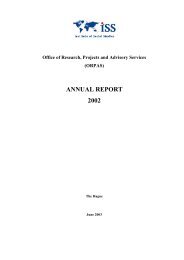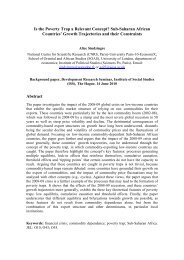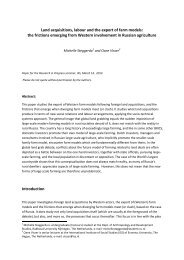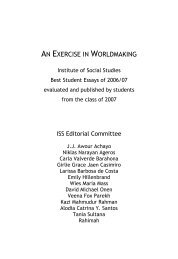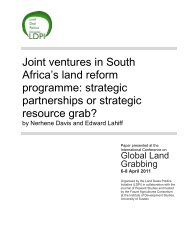AN EXERCISE IN WORLDMAKING 2009 - ISS
AN EXERCISE IN WORLDMAKING 2009 - ISS
AN EXERCISE IN WORLDMAKING 2009 - ISS
You also want an ePaper? Increase the reach of your titles
YUMPU automatically turns print PDFs into web optimized ePapers that Google loves.
14 Unpacking the Politics of Veil in the Context of Bangladesh 163<br />
In the left photo the first two girls are wearing<br />
chador; in the right photo, the girl in the middle is wearing a chador.<br />
My use of the term ‘veil’ in the case of Bangladesh means Burqa, not<br />
the headscarf or chador, because unlike the headscarf and chador, burqa<br />
is labeled as conservative and a symbol of oppression by feminist groups<br />
and as a symbol of piety, modesty and “good Muslim women” by religious<br />
fundamentalists. Chadors, head covers and scarves are considered<br />
as socially accepted forms of dress, yet there is no imposition to adopt<br />
such veils. Difference in attitudes towards different types of veil needs<br />
another paper to explain; therefore, this paper only focuses on the complexities<br />
of burqa. In addition, similar to Scott (2007: 16), I also find it<br />
difficult to make rigorous distinction in my own terminology; therefore,<br />
my use of ‘veil’ and ‘burqa’ interchangeably reflects the way they are deployed<br />
in the debate.<br />
In most recent discussions of Islam, burqa and purdah have been<br />
noted as the same, however for Bangladesh there are discrepancies between<br />
burqa and purdah (Feldman and McCarthy, 1983: 950-52; Kirleis,<br />
1991: 31-32). Here, purdah in its literal sense means spatial segregation<br />
and the seclusion of women. Purdah has been operated as a means of<br />
restraining and prohibiting women’s visibility inside and outside the<br />
household. In addition, it is closely linked with the socio-economic status<br />
of women. Though it has been identified as a Muslim practice, for Bangladesh<br />
it is more a social than religious practice, which simultaneously<br />
exists within Muslim, Buddhist, Hindu, and other religious communities<br />
(Feldman and McCarthy, 1983: 950-52; Kirleis, 1991: 31-32). In contrast,<br />
various studies (Feldman and McCarthy, 1983: 953-54; Abu-Lughod,<br />
2002: 785) note that in pre-colonial Bangladesh burqa was a liberating<br />
invention for upper class Muslim women, whose male kin could afford<br />
to go to Haj (religious trip to Mecca) where they purchased it for females<br />
in the family. It enhanced their physical mobility allowing them to move




